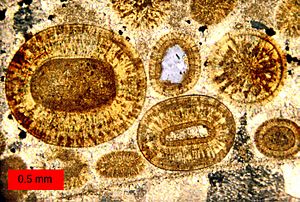Cementation facts for kids
Cementation is a natural process that turns loose sand, mud, and gravel into solid rocks. Think of it like a natural glue that sticks tiny pieces of sediment together. Without cementation, many rocks we see today would still be just piles of loose grains!
Contents
How Rocks Get Solid
Cementation is a chemical process that happens underground. It's how "sediment" (loose bits of rock, sand, or mud) becomes "rock."
Here's how it works:
- Water moves through the tiny spaces between sediment grains. This water often has dissolved minerals in it.
- Over a very long time, these dissolved minerals can start to crystallize and fill those empty spaces.
- These new mineral crystals act like a natural cement, binding the sediment grains together. They form tiny "bridges" that connect the grains.
For example, when sand grains get cemented together, they form a solid rock called sandstone. If gravel pieces are cemented, they become a rock called conglomerate.
Common Types of Natural Cement
The most common types of natural cement found in rocks are:
- Silica (SiO2): This is the same material that makes up quartz and sand.
- Calcium carbonate (CaCO3): This is the main ingredient in seashells, chalk, and limestone.
How Long Does Cementation Take?
Cementation usually happens deep underground, below the level where groundwater sits (the water table). It takes a very long time because a lot of water needs to flow through the sediment for enough minerals to crystallize. This process can take millions of years to fully turn loose sediment into hard rock.
When Rocks Don't Harden
Sometimes, even after millions of years, sediment doesn't turn into solid rock. This happens if the right conditions for cementation never occur. For example, many quarries in England dig up sand and gravel that are still loose, even though they were laid down over 150 million years ago during the Jurassic period. They look just like sand and gravel you might find on a modern beach!


